
Vladimir Shukhov
Encyclopedia
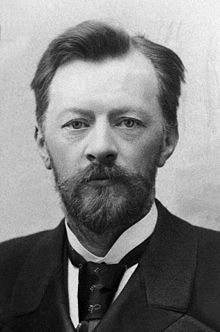
Russia
Russia or , officially known as both Russia and the Russian Federation , is a country in northern Eurasia. It is a federal semi-presidential republic, comprising 83 federal subjects...
n engineer
Engineer
An engineer is a professional practitioner of engineering, concerned with applying scientific knowledge, mathematics and ingenuity to develop solutions for technical problems. Engineers design materials, structures, machines and systems while considering the limitations imposed by practicality,...
-polymath
Polymath
A polymath is a person whose expertise spans a significant number of different subject areas. In less formal terms, a polymath may simply be someone who is very knowledgeable...
, scientist
Scientist
A scientist in a broad sense is one engaging in a systematic activity to acquire knowledge. In a more restricted sense, a scientist is an individual who uses the scientific method. The person may be an expert in one or more areas of science. This article focuses on the more restricted use of the word...
and architect
Architect
An architect is a person trained in the planning, design and oversight of the construction of buildings. To practice architecture means to offer or render services in connection with the design and construction of a building, or group of buildings and the space within the site surrounding the...
renowned for his pioneering works on new methods of analysis for structural engineering
Structural engineering
Structural engineering is a field of engineering dealing with the analysis and design of structures that support or resist loads. Structural engineering is usually considered a specialty within civil engineering, but it can also be studied in its own right....
that led to breakthroughs in industrial design
Industrial design
Industrial design is the use of a combination of applied art and applied science to improve the aesthetics, ergonomics, and usability of a product, but it may also be used to improve the product's marketability and production...
of world's first hyperboloid structure
Hyperboloid structure
Hyperboloid structures are architectural structures designed with hyperboloid geometry. Often these are tall structures such as towers where the hyperboloid geometry's structural strength is used to support an object high off the ground, but hyperboloid geometry is also often used for decorative...
s, lattice shell structures
Thin-shell structure
Thin-shell structures are light weight constructions using shell elements. These elements are typically curved and are assembled to large structures...
, tensile structure
Tensile structure
A tensile structure is a construction of elements carrying only tension and no compression or bending. The term tensile should not be confused with tensegrity, which is a structural form with both tension and compression elements....
s, gridshell
Gridshell
A gridshell is a structure which derives its strength from its double curvature , but is constructed of a grid or lattice....
structures, oil reservoir
Oil reservoir
A petroleum reservoir, or oil and gas reservoir, is a subsurface pool of hydrocarbons contained in porous or fractured rock formations. The naturally occurring hydrocarbons, such as crude oil or natural gas, are trapped by overlying rock formations with lower permeability...
s, pipelines
Pipeline transport
Pipeline transport is the transportation of goods through a pipe. Most commonly, liquids and gases are sent, but pneumatic tubes that transport solid capsules using compressed air are also used....
, boiler
Boiler
A boiler is a closed vessel in which water or other fluid is heated. The heated or vaporized fluid exits the boiler for use in various processes or heating applications.-Materials:...
s, ships and barge
Barge
A barge is a flat-bottomed boat, built mainly for river and canal transport of heavy goods. Some barges are not self-propelled and need to be towed by tugboats or pushed by towboats...
s.
Besides the innovations he brought to the oil industry and the construction of numerous bridges and buildings, Shukhov was the inventor of a new family of doubly curved structural forms. These forms, based on non-Euclidean hyperbolic geometry
Geometry
Geometry arose as the field of knowledge dealing with spatial relationships. Geometry was one of the two fields of pre-modern mathematics, the other being the study of numbers ....
, are known today as hyperboloids of revolution. Shukhov developed not only many varieties of light-weight hyperboloid tower
Tower
A tower is a tall structure, usually taller than it is wide, often by a significant margin. Towers are distinguished from masts by their lack of guy-wires....
s and roof
Roof
A roof is the covering on the uppermost part of a building. A roof protects the building and its contents from the effects of weather. Structures that require roofs range from a letter box to a cathedral or stadium, dwellings being the most numerous....
systems, but also the mathematics for their analysis. Shukhov is particularly reputed for his original designs of hyperboloid towers
Hyperboloid structure
Hyperboloid structures are architectural structures designed with hyperboloid geometry. Often these are tall structures such as towers where the hyperboloid geometry's structural strength is used to support an object high off the ground, but hyperboloid geometry is also often used for decorative...
such as the Shukhov Tower
Shukhov Tower
The Shukhov radio tower , also known as the Shabolovka tower, is a broadcasting tower in Moscow designed by Vladimir Shukhov. The 160-metre-high free-standing steel structure was built in the period 1920–1922, during the Russian Civil War...
.
Biography
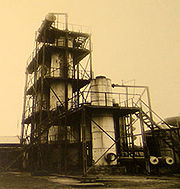
Belgorod
-Twin towns/sister cities:Belgorod is twinned with: Wakefield, England, United Kingdom Herne, North Rhine-Westphalia, Germany Palembang, South Sumatra, Indonesia Opole, Poland Vyshhorod, Ukraine Kharkiv, Ukraine-External links:...
uezd, Kursk
Kursk
Kursk is a city and the administrative center of Kursk Oblast, Russia, located at the confluence of the Kur, Tuskar, and Seym Rivers. The area around Kursk was site of a turning point in the Russian-German struggle during World War II and the site of the largest tank battle in history...
gubernia (in present-day Belgorod Oblast
Belgorod Oblast
Belgorod Oblast is a federal subjects of Russia . Its administrative center is the city of Belgorod. Population: 1,532,670 .-History:...
) into a petty noble family. His father Grigory Ivanovich Shukhov was a minor government official, promoted for his efforts in the Crimean War
Crimean War
The Crimean War was a conflict fought between the Russian Empire and an alliance of the French Empire, the British Empire, the Ottoman Empire, and the Kingdom of Sardinia. The war was part of a long-running contest between the major European powers for influence over territories of the declining...
. For a while, Grigory served as Mayor
Mayor
In many countries, a Mayor is the highest ranking officer in the municipal government of a town or a large urban city....
of Graivoron and later as an administrator in Warsaw
Warsaw
Warsaw is the capital and largest city of Poland. It is located on the Vistula River, roughly from the Baltic Sea and from the Carpathian Mountains. Its population in 2010 was estimated at 1,716,855 residents with a greater metropolitan area of 2,631,902 residents, making Warsaw the 10th most...
.
In 1864 Vladimir entered Saint Petersburg
Saint Petersburg
Saint Petersburg is a city and a federal subject of Russia located on the Neva River at the head of the Gulf of Finland on the Baltic Sea...
gymnasium
Gymnasium (school)
A gymnasium is a type of school providing secondary education in some parts of Europe, comparable to English grammar schools or sixth form colleges and U.S. college preparatory high schools. The word γυμνάσιον was used in Ancient Greece, meaning a locality for both physical and intellectual...
from which he graduated with distinction in 1871. During his high school years he showed mathematical talents, once demonstrating to his classmates and teacher an original proof
Mathematical proof
In mathematics, a proof is a convincing demonstration that some mathematical statement is necessarily true. Proofs are obtained from deductive reasoning, rather than from inductive or empirical arguments. That is, a proof must demonstrate that a statement is true in all cases, without a single...
of the Pythagorean theorem
Pythagorean theorem
In mathematics, the Pythagorean theorem or Pythagoras' theorem is a relation in Euclidean geometry among the three sides of a right triangle...
. The teacher praised his skills but he failed the grade for violating the textbook's guidelines.

Pafnuty Chebyshev
Pafnuty Lvovich Chebyshev was a Russian mathematician. His name can be alternatively transliterated as Chebychev, Chebysheff, Chebyshov, Tschebyshev, Tchebycheff, or Tschebyscheff .-Early years:One of nine children, Chebyshev was born in the village of Okatovo in the district of Borovsk,...
, Aleksey Letnikov
Aleksey Letnikov
Aleksey Vasilievich Letnikov , was a Russian mathematician.Aleksey graduated from the Constantin Institute for Border-lines in Moscow. After graduation he attended classes at the Moscow University and Sorbonne. In 1860 he became an Instructor of Mathematics at the Constantin Institute. He...
, and Nikolay Zhukovsky. In 1876 Shukhov graduated from the school with distinction and a Gold Medal. Chebyshev proposed to him a job as a lecturer in mathematics at the Imperial Moscow Technical School, but Shukhov decided to seek a job in the industry instead.
Thereupon Shukhov went to Philadelphia, to work on the Russian pavilion at the World's Fair
World's Fair
World's fair, World fair, Universal Exposition, and World Expo are various large public exhibitions held in different parts of the world. The first Expo was held in The Crystal Palace in Hyde Park, London, United Kingdom, in 1851, under the title "Great Exhibition of the Works of Industry of All...
and to study the inner workings of the American industry. During his stay in the US Shukhov came to know a Russian-American entrepreneur, Alexander Veniaminovich Bari (Александр Вениаминович Бари) who also worked on the organization of the Fair.
In 1877 Shukhov returned to Russia and joined the drafting office of the Warsaw-Vienna
Vienna
Vienna is the capital and largest city of the Republic of Austria and one of the nine states of Austria. Vienna is Austria's primary city, with a population of about 1.723 million , and is by far the largest city in Austria, as well as its cultural, economic, and political centre...
railroad. Within several months, Shukhov's frustration with standard and routine engineering made him abandon the office and join a military-medical academy.
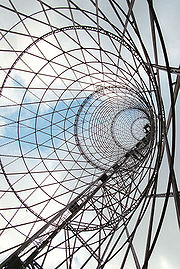
October Revolution
The October Revolution , also known as the Great October Socialist Revolution , Red October, the October Uprising or the Bolshevik Revolution, was a political revolution and a part of the Russian Revolution of 1917...
. Their works revolutionized many areas of civil engineering, ship engineering, and oil industry. The thermal cracking
Cracking (chemistry)
In petroleum geology and chemistry, cracking is the process whereby complex organic molecules such as kerogens or heavy hydrocarbons are broken down into simpler molecules such as light hydrocarbons, by the breaking of carbon-carbon bonds in the precursors. The rate of cracking and the end products...
method, the Shukhov cracking process
Shukhov cracking process
The Shukhov cracking process is a thermal cracking process invented by Vladimir Shukhov and Sergei Gavrilov. Shukhov designed and built the first thermal cracking techniques important to the petrochemical industry. His patent The Shukhov cracking process is a thermal cracking process invented by...
, was patented by Vladimir Shukhov in 1891.
Shukhov always found time for a passionate hobby
Hobby
A hobby is a regular activity or interest that is undertaken for pleasure, typically done during one's leisure time.- Etymology :A hobby horse is a wooden or wickerwork toy made to be ridden just like a real horse...
– photography. The photographic works of Shukhov opened new trends ahead of their flourishing of Fine art photography
Fine art photography
Fine art photography refers to photographs that are created in accordance with the creative vision of the photographer as artist. Fine art photography stands in contrast to photojournalism, which provides a visual account for news events, and commercial photography, the primary focus of which is to...
. He made photos in various genre
Genre
Genre , Greek: genos, γένος) is the term for any category of literature or other forms of art or culture, e.g. music, and in general, any type of discourse, whether written or spoken, audial or visual, based on some set of stylistic criteria. Genres are formed by conventions that change over time...
s: reporting, city landscape
Landscape
Landscape comprises the visible features of an area of land, including the physical elements of landforms such as mountains, hills, water bodies such as rivers, lakes, ponds and the sea, living elements of land cover including indigenous vegetation, human elements including different forms of...
, portrait
Portrait
thumb|250px|right|Portrait of [[Thomas Jefferson]] by [[Rembrandt Peale]], 1805. [[New-York Historical Society]].A portrait is a painting, photograph, sculpture, or other artistic representation of a person, in which the face and its expression is predominant. The intent is to display the likeness,...
, constructivism
Constructivism (art)
Constructivism was an artistic and architectural philosophy that originated in Russia beginning in 1919, which was a rejection of the idea of autonomous art. The movement was in favour of art as a practice for social purposes. Constructivism had a great effect on modern art movements of the 20th...
. About two thousand photos and negatives made by Shukhov have survived until this day.
After the October Revolution Shukhov decided to stay in the Soviet Union
Soviet Union
The Soviet Union , officially the Union of Soviet Socialist Republics , was a constitutionally socialist state that existed in Eurasia between 1922 and 1991....
despite having received alluring job offers from around the world. Many signal Soviet engineering projects of the 1920s were associated with his name. In 1919 he framed his slogan: We should work independently from politics. The buildings, boilers, beams would be needed and so would we. In the later 1930s during the Great Purge
Great Purge
The Great Purge was a series of campaigns of political repression and persecution in the Soviet Union orchestrated by Joseph Stalin from 1936 to 1938...
he retired from engineering work but was not arrested or persecuted.
Shukov died on February 2, 1939 in Moscow and was buried at the Novodevichy Cemetery
Novodevichy Convent
Novodevichy Convent, also known as Bogoroditse-Smolensky Monastery is probably the best-known cloister of Moscow. Its name, sometimes translated as the New Maidens' Monastery, was devised to differ from an ancient maidens' convent within the Moscow Kremlin. Unlike other Moscow cloisters, it has...
. His many honours included the Lenin Prize
Lenin Prize
The Lenin Prize was one of the most prestigious awards of the USSR, presented to individuals for accomplishments relating to science, literature, arts, architecture, and technology. It was created on June 23, 1925 and was awarded until 1934. During the period from 1935 to 1956, the Lenin Prize was...
(1929) and the title of Hero of Labour (1932).
Works
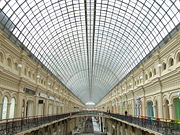
Thomas Edison
Thomas Alva Edison was an American inventor and businessman. He developed many devices that greatly influenced life around the world, including the phonograph, the motion picture camera, and a long-lasting, practical electric light bulb. In addition, he created the world’s first industrial...
for the sheer quantity and quality of his pioneering works. He was one of the first to develop practical calculations of stress
Stress (physics)
In continuum mechanics, stress is a measure of the internal forces acting within a deformable body. Quantitatively, it is a measure of the average force per unit area of a surface within the body on which internal forces act. These internal forces are a reaction to external forces applied on the body...
es and deformations of beams
Beam (structure)
A beam is a horizontal structural element that is capable of withstanding load primarily by resisting bending. The bending force induced into the material of the beam as a result of the external loads, own weight, span and external reactions to these loads is called a bending moment.- Overview...
, shells and membranes on elastic foundation. These theoretical results allowed him to design the first Russian oil tanker, new types of oil tanker barges, and a new type of oil reservoirs. The same principle of the shell on an elastic foundation allowed to theoretically calculate the optimal diameter, wall thickness and fluid speed for the fluid pipelines. Shukhov's projects were instrumental in constructing:
- An oil pipelinePipeline transportPipeline transport is the transportation of goods through a pipe. Most commonly, liquids and gases are sent, but pneumatic tubes that transport solid capsules using compressed air are also used....
, the first in the Russian EmpireRussian EmpireThe Russian Empire was a state that existed from 1721 until the Russian Revolution of 1917. It was the successor to the Tsardom of Russia and the predecessor of the Soviet Union...
, between Balkhany and Cherny Gorod near BakuBakuBaku , sometimes spelled as Baki or Bakou, is the capital and largest city of Azerbaijan, as well as the largest city on the Caspian Sea and of the Caucasus region. It is located on the southern shore of the Absheron Peninsula, which projects into the Caspian Sea. The city consists of two principal...
(12 km, 1878 complete, used by the BranobelBranobelThe Petroleum Production Company Nobel Brothers, Limited,or Branobel , was an oil company set up by Ludvig Nobel and Baron Peter von Bilderling, in Baku, Azerbaijan...
). By 1883 the total length of Shukhov-designed, Bari-built oil pipelines in Baku exceeded 94 km, transporting 30 thousands barrelBarrelA barrel or cask is a hollow cylindrical container, traditionally made of vertical wooden staves and bound by wooden or metal hoops. Traditionally, the barrel was a standard size of measure referring to a set capacity or weight of a given commodity. A small barrel is called a keg.For example, a...
s of oil per day. In 1894 a similar pipeline network was built in GroznyGroznyGrozny is the capital city of the Chechen Republic, Russia. The city lies on the Sunzha River. According to the preliminary results of the 2010 Census, the city had a population of 271,596; up from 210,720 recorded in the 2002 Census. but still only about two-thirds of 399,688 recorded in the 1989...
. Shukhov designed the first Trans-Caucasian keroseneKeroseneKerosene, sometimes spelled kerosine in scientific and industrial usage, also known as paraffin or paraffin oil in the United Kingdom, Hong Kong, Ireland and South Africa, is a combustible hydrocarbon liquid. The name is derived from Greek keros...
pipeline between Baku and BatumiBaku-Batumi pipelineThe Baku–Batumi pipeline is the name given to several pipelines and pipeline projects to transport kerosene and crude oil from the Caspian region to the Georgian Batumi oil terminal at the Black Sea...
(835 km long) and Grozny-Tuapse pipelineGrozny-Tuapse oil pipelineThe Grozny-Tuapse oil pipeline is a long pipeline connecting oil fields near Grozny, Russia, with sea port Tuapse. The pipeline was launched in 1928, designed by Vladimir Shukhov. The annual throughput of the pipeline along with its 11 pumping stations was 1.5 million tons. It used pipes, both...
(618 km long).
- A superior design for water-mains. Shukhov designed (and Bari built) complete water-supply systems for the cities of Cherkassy, TambovTambovTambov is a city and the administrative center of Tambov Oblast, Russia, located at the confluence of the Tsna and Studenets Rivers southeast of Moscow...
, Kharkov, VoronezhVoronezhVoronezh is a city in southwestern Russia, the administrative center of Voronezh Oblast. It is located on both sides of the Voronezh River, away from where it flows into the Don. It is an operating center of the Southeastern Railway , as well as the center of the Don Highway...
and many others. In that age of infectious diseases his water-supply systems literally saved thousands of lives. - A superior design for oil-tanker barges (less than half of the metal previously required), 84 150-meters long barges were built (mostly for the Volga river) as well as the first Russian seaworthy oil tankerOil tankerAn oil tanker, also known as a petroleum tanker, is a merchant ship designed for the bulk transport of oil. There are two basic types of oil tankers: the crude tanker and the product tanker. Crude tankers move large quantities of unrefined crude oil from its point of extraction to refineries...
ship. His approach to the ship strength analysis (using the model of a shell on an elastic foundation) was absolutely novel for that time. - Shukhov-designed inexpensive oil tanks with the bottom calculated as a membrane on elastic foundation. They became very popular among oil-producers of the Imperial Russia. By 1881, 130 such tanks were built in BakuBakuBaku , sometimes spelled as Baki or Bakou, is the capital and largest city of Azerbaijan, as well as the largest city on the Caspian Sea and of the Caucasus region. It is located on the southern shore of the Absheron Peninsula, which projects into the Caspian Sea. The city consists of two principal...
alone.
Shukhov made important contributions to the chemical industry:
- He designed and built an oilOilAn oil is any substance that is liquid at ambient temperatures and does not mix with water but may mix with other oils and organic solvents. This general definition includes vegetable oils, volatile essential oils, petrochemical oils, and synthetic oils....
crackingCracking (chemistry)In petroleum geology and chemistry, cracking is the process whereby complex organic molecules such as kerogens or heavy hydrocarbons are broken down into simpler molecules such as light hydrocarbons, by the breaking of carbon-carbon bonds in the precursors. The rate of cracking and the end products...
plant. His patents (Shukhov cracking processShukhov cracking processThe Shukhov cracking process is a thermal cracking process invented by Vladimir Shukhov and Sergei Gavrilov. Shukhov designed and built the first thermal cracking techniques important to the petrochemical industry. His patent The Shukhov cracking process is a thermal cracking process invented by...
- patent of Russian empire No. 12926 from November, 27th, 1891) on cracking were used to invalidate Standard OilStandard OilStandard Oil was a predominant American integrated oil producing, transporting, refining, and marketing company. Established in 1870 as a corporation in Ohio, it was the largest oil refiner in the world and operated as a major company trust and was one of the world's first and largest multinational...
's patents (Burton processBurton processThe Burton process is a thermal cracking process invented by William Merriam Burton and Robert Humphrey.The oil industry used it to double the production of gasoline in 1913. This thermal cracking process was patented on January 7, 1913 ....
– Patent of USA No. 1,049,667 on January 7, 1913) on oil refineriesOil refineryAn oil refinery or petroleum refinery is an industrial process plant where crude oil is processed and refined into more useful petroleum products, such as gasoline, diesel fuel, asphalt base, heating oil, kerosene, and liquefied petroleum gas...
.
- He designed an original oil pumpPumpA pump is a device used to move fluids, such as liquids, gases or slurries.A pump displaces a volume by physical or mechanical action. Pumps fall into three major groups: direct lift, displacement, and gravity pumps...
. Shukhov's pumps revolutionized Baku's oil industry allowing to increase its oil output. - He designed one of the first furnaceFurnaceA furnace is a device used for heating. The name derives from Latin fornax, oven.In American English and Canadian English, the term furnace on its own is generally used to describe household heating systems based on a central furnace , and sometimes as a synonym for kiln, a device used in the...
s that used the residual oil: before his works the residual oil was considered a waste and was discarded, due to his works it became recognized as an important technical product known as a fuel oil.
Shukhov also left a lasting legacy to the Constructivist architecture
Constructivist architecture
Constructivist architecture was a form of modern architecture that flourished in the Soviet Union in the 1920s and early 1930s. It combined advanced technology and engineering with an avowedly Communist social purpose. Although it was divided into several competing factions, the movement produced...
of early Soviet Russia. As a leading specialist of metallic structures (hyperboloid structure
Hyperboloid structure
Hyperboloid structures are architectural structures designed with hyperboloid geometry. Often these are tall structures such as towers where the hyperboloid geometry's structural strength is used to support an object high off the ground, but hyperboloid geometry is also often used for decorative...
s, thin-shell structure
Thin-shell structure
Thin-shell structures are light weight constructions using shell elements. These elements are typically curved and are assembled to large structures...
s, tensile structure
Tensile structure
A tensile structure is a construction of elements carrying only tension and no compression or bending. The term tensile should not be confused with tensegrity, which is a structural form with both tension and compression elements....
s), he may be compared with Gustave Eiffel
Gustave Eiffel
Alexandre Gustave Eiffel was a French structural engineer from the École Centrale Paris, an architect, an entrepreneur and a specialist of metallic structures...
. Shukhov's innovative and exquisite constructions still grace many towns across the former Russian Empire
Russian Empire
The Russian Empire was a state that existed from 1721 until the Russian Revolution of 1917. It was the successor to the Tsardom of Russia and the predecessor of the Soviet Union...
:
- Eight thin-shell structureThin-shell structureThin-shell structures are light weight constructions using shell elements. These elements are typically curved and are assembled to large structures...
s exhibition pavilions for the All-Russia ExhibitionAll-Russia exhibition 1896The All-Russia industrial and art exhibition 1896 in Nizhny Novgorod was held from May 28 till October 1 , 1896. The 1896 exhibition was the biggest pre-revolution exhibition in Russian Empire and was organized with the money allotted by Nicholas II, Emperor of Russia...
in Nizhny NovgorodNizhny NovgorodNizhny Novgorod , colloquially shortened to Nizhny, is, with the population of 1,250,615, the fifth largest city in Russia, ranking after Moscow, St. Petersburg, Novosibirsk, and Yekaterinburg...
of 1896, covering the area of 27,000 m², and featuring an unorthodox water-tower that served as a model for more than 30 similar structures built in Imperial Russia, and thousands around the world now.
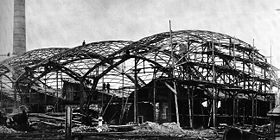
- About 200 original towers (hyperboloid steel gridshellGridshellA gridshell is a structure which derives its strength from its double curvature , but is constructed of a grid or lattice....
s) all over the world, the most famous being the 160-meter-high Shukhov TowerShukhov TowerThe Shukhov radio tower , also known as the Shabolovka tower, is a broadcasting tower in Moscow designed by Vladimir Shukhov. The 160-metre-high free-standing steel structure was built in the period 1920–1922, during the Russian Civil War...
in Moscow (1922) and 70-meter-high Adziogol LighthouseAdziogol LighthouseAdziogol Lighthouse , also known as Stanislav Range Rear Light, is a vertical lattice hyperboloid structure of steel bars, serving as an active lighthouse, about from Kherson, Ukraine...
near KhersonKhersonKherson is a city in southern Ukraine. It is the administrative center of the Kherson Oblast , and is designated as its own separate raion within the oblast. Kherson is an important port on the Black Sea and Dnieper River, and the home of a major ship-building industry...
(1910). On Shukhov's 110th birthday in 1963 Soviet UnionSoviet UnionThe Soviet Union , officially the Union of Soviet Socialist Republics , was a constitutionally socialist state that existed in Eurasia between 1922 and 1991....
issued a postal stamp showing Shukhov and his tower (pictured). - Spacious elongated shop galleries, bridged with innovative metal-and-glass vaults, notably the Upper Trade Rows on Red SquareRed SquareRed Square is a city square in Moscow, Russia. The square separates the Kremlin, the former royal citadel and currently the official residence of the President of Russia, from a historic merchant quarter known as Kitai-gorod...
(1889–94), Pushkin Museum of Fine ArtsPushkin MuseumThe Pushkin Museum of Fine Arts is the largest museum of European art in Moscow, located in Volkhonka street, just opposite the Cathedral of Christ the Saviour....
(1898–1912) and Petrovka Passage (1903–06). - Enormous metal arch vaulting for the Municipal Railway Park (1908) and the Kievskiy Railway Station in Moscow (1912–17).
- The colossal hall of the Central Post Office, Moscow (1911–13).
- Truss-supported metal framework for the Central Universal Store in Moscow (1906–08).
- A rotating scene for the Moscow Art TheatreMoscow Art TheatreThe Moscow Art Theatre is a theatre company in Moscow that the seminal Russian theatre practitioner Constantin Stanislavski, together with the playwright and director Vladimir Nemirovich-Danchenko, founded in 1898. It was conceived as a venue for naturalistic theatre, in contrast to the melodramas...
. - Several ConstructivistConstructivism (art)Constructivism was an artistic and architectural philosophy that originated in Russia beginning in 1919, which was a rejection of the idea of autonomous art. The movement was in favour of art as a practice for social purposes. Constructivism had a great effect on modern art movements of the 20th...
projects, designed in collaboration with Konstantin MelnikovKonstantin MelnikovKonstantin Stepanovich Melnikov was a Russian architect and painter. His architectural work, compressed into a single decade , placed Melnikov on the front end of 1920s avant-garde architecture...
, notably the Bakhmetevsky Bus GarageBakhmetevsky Bus GarageBakhmetevsky Bus Garage was a public bus garage in Moscow, designed in 1926 by Konstantin Melnikov and Vladimir Shukhov . The building, completed in 1927, was an example of applying avant-garde architectural methods to an industrial facility...
(1926–28) and Novo-Ryazanskaya Street GarageNovo-Ryazanskaya Street GarageNovoryazanskaya Street Garage, also spelled Novo-Ryazanskaya Street Garage, and known as "Horseshoe garage", was designed by Konstantin Melnikov and Vladimir Shukhov in 1926 and completed in 1929 at 27, Novoryazanskaya Street in Krasnoselsky District, Moscow, Russia, near Kazansky Rail...
(1926–29). - More than 180 bridgeBridgeA bridge is a structure built to span physical obstacles such as a body of water, valley, or road, for the purpose of providing passage over the obstacle...
s across the Volga, Yenisey, Dnieper, and other rivers. - Stabilization MinaretMinaretA minaret مناره , sometimes مئذنه) is a distinctive architectural feature of Islamic mosques, generally a tall spire with an onion-shaped or conical crown, usually either free standing or taller than any associated support structure. The basic form of a minaret includes a base, shaft, and gallery....
of the MadrasahMadrasahMadrasah is the Arabic word for any type of educational institution, whether secular or religious...
Ulugh BegUlugh BegUlugh Bek was a Timurid ruler as well as an astronomer, mathematician and sultan. His commonly-known name is not truly a personal name, but rather a moniker, which can be loosely translated as "Great Ruler" or "Patriarch Ruler" and was the Turkic equivalent of Timur's Perso-Arabic title Amīr-e...
in SamarkandSamarkandAlthough a Persian-speaking region, it was not united politically with Iran most of the times between the disintegration of the Seleucid Empire and the Arab conquest . In the 6th century it was within the domain of the Turkic kingdom of the Göktürks.At the start of the 8th century Samarkand came...
(Shukhov's last engineering work).
See also
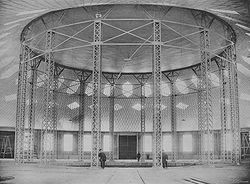
- Shukhov cracking processShukhov cracking processThe Shukhov cracking process is a thermal cracking process invented by Vladimir Shukhov and Sergei Gavrilov. Shukhov designed and built the first thermal cracking techniques important to the petrochemical industry. His patent The Shukhov cracking process is a thermal cracking process invented by...
- GridshellGridshellA gridshell is a structure which derives its strength from its double curvature , but is constructed of a grid or lattice....
- Hyperboloid structureHyperboloid structureHyperboloid structures are architectural structures designed with hyperboloid geometry. Often these are tall structures such as towers where the hyperboloid geometry's structural strength is used to support an object high off the ground, but hyperboloid geometry is also often used for decorative...
- Tensile and membrane structuresTensile structureA tensile structure is a construction of elements carrying only tension and no compression or bending. The term tensile should not be confused with tensegrity, which is a structural form with both tension and compression elements....
- Constructivist architectureConstructivist architectureConstructivist architecture was a form of modern architecture that flourished in the Soviet Union in the 1920s and early 1930s. It combined advanced technology and engineering with an avowedly Communist social purpose. Although it was divided into several competing factions, the movement produced...
- All-Russia exhibition 1896All-Russia exhibition 1896The All-Russia industrial and art exhibition 1896 in Nizhny Novgorod was held from May 28 till October 1 , 1896. The 1896 exhibition was the biggest pre-revolution exhibition in Russian Empire and was organized with the money allotted by Nicholas II, Emperor of Russia...
- History of structural engineeringHistory of structural engineeringThe history of structural engineering dates back to at least 2700 BC when the step pyramid for Pharaoh Djoser was built by Imhotep, the first engineer in history known by name...
Major works
- Grozny-Tuapse pipelineGrozny-Tuapse oil pipelineThe Grozny-Tuapse oil pipeline is a long pipeline connecting oil fields near Grozny, Russia, with sea port Tuapse. The pipeline was launched in 1928, designed by Vladimir Shukhov. The annual throughput of the pipeline along with its 11 pumping stations was 1.5 million tons. It used pipes, both...
- Shukhov TowerShukhov TowerThe Shukhov radio tower , also known as the Shabolovka tower, is a broadcasting tower in Moscow designed by Vladimir Shukhov. The 160-metre-high free-standing steel structure was built in the period 1920–1922, during the Russian Civil War...
- Shukhov RotundaShukhov RotundaShukhov Rotunda, round exhibition pavilion for the All-Russia Exhibition in Nizhny Novgorod of 1896 with lattice hanging covering and the World First Membrane roof . Designed by Vladimir Shukhov in 1895...
- Adziogol LighthouseAdziogol LighthouseAdziogol Lighthouse , also known as Stanislav Range Rear Light, is a vertical lattice hyperboloid structure of steel bars, serving as an active lighthouse, about from Kherson, Ukraine...
- The world's first Hyperboloid structurePolibino, Lipetsk OblastPolibino is a village in Dankovsky District of Lipetsk Oblast, Russia. A historical estate of Russian aristocrats Nechayevs is located there.The estate is composed of a palace, English park, regular gardens, ponds, and more...
- Shukhov tower on the Oka RiverShukhov tower on the Oka RiverThe Shukhov Tower on the Oka River is the world’s only hyperboloid electricity pylon. It is located in Russia, in the western suburbs of Nizhny Novgorod, on the left bank of the Oka River near Dzerzhinsk...
- Pushkin MuseumPushkin MuseumThe Pushkin Museum of Fine Arts is the largest museum of European art in Moscow, located in Volkhonka street, just opposite the Cathedral of Christ the Saviour....
- Moscow GUMState Universal StoreGUM is the name of the main department store in many cities of the former Soviet Union, known as State Department Store during the Soviet times. Similar-named stores were in some Soviet republics and post-Soviet states. The most famous GUM is a large store in the Kitai-gorod part of Moscow,...
- Novo-Ryazanskaya Street GarageNovo-Ryazanskaya Street GarageNovoryazanskaya Street Garage, also spelled Novo-Ryazanskaya Street Garage, and known as "Horseshoe garage", was designed by Konstantin Melnikov and Vladimir Shukhov in 1926 and completed in 1929 at 27, Novoryazanskaya Street in Krasnoselsky District, Moscow, Russia, near Kazansky Rail...
- Bakhmetevsky Bus GarageBakhmetevsky Bus GarageBakhmetevsky Bus Garage was a public bus garage in Moscow, designed in 1926 by Konstantin Melnikov and Vladimir Shukhov . The building, completed in 1927, was an example of applying avant-garde architectural methods to an industrial facility...
- Kievskiy Railway Station
- Hotel Metropol (Moscow)Hotel Metropol (Moscow)Hotel Metropol is a historical hotel in the center of Moscow, Russia, built in 1899-1907 in Art Nouveau style. It is notable as the largest extant Moscow hotel built before the Russian Revolution of 1917, and for the unique collaboration of architects and artists .In 1898, Savva Mamontov...
- Petrovsky PassagePetrovsky PassagePetrovsky Passage is an elite department store opened on Petrovka Street in downtown Moscow in 1906. The engineer Vladimir Shukhov, also responsible for the GUM and the Shabolovka tower, designed a covered arcade with two wide three-storey galleries covered with high-pitched semi-cylindrical glass...
- Water-main in Cherkassy

